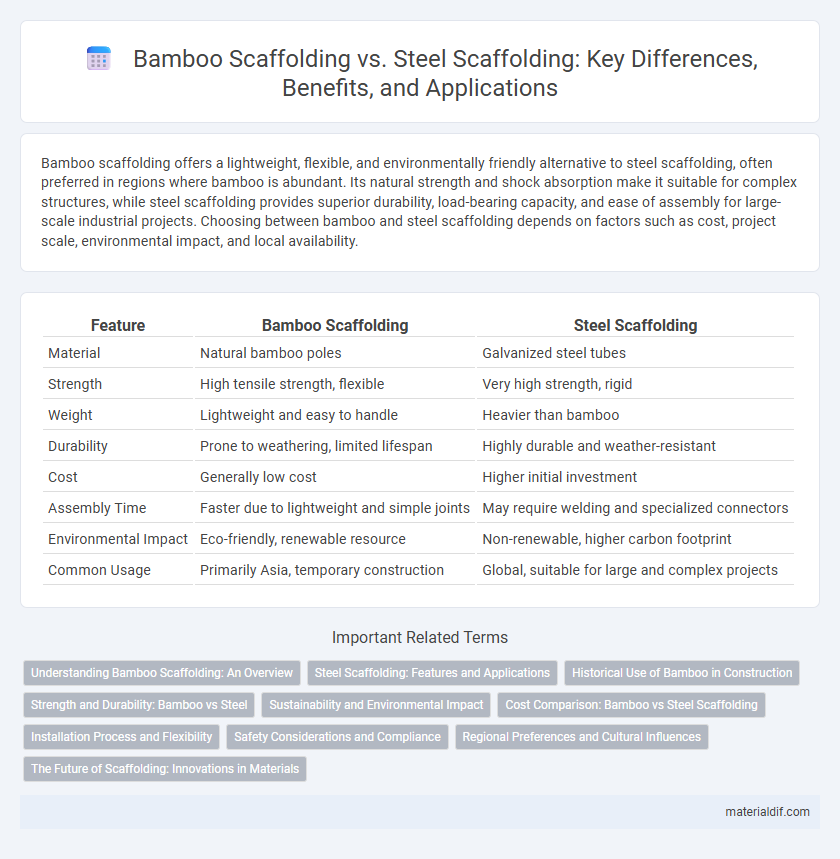Bamboo scaffolding offers a lightweight, flexible, and environmentally friendly alternative to steel scaffolding, often preferred in regions where bamboo is abundant. Its natural strength and shock absorption make it suitable for complex structures, while steel scaffolding provides superior durability, load-bearing capacity, and ease of assembly for large-scale industrial projects. Choosing between bamboo and steel scaffolding depends on factors such as cost, project scale, environmental impact, and local availability.
Table of Comparison
| Feature | Bamboo Scaffolding | Steel Scaffolding |
|---|---|---|
| Material | Natural bamboo poles | Galvanized steel tubes |
| Strength | High tensile strength, flexible | Very high strength, rigid |
| Weight | Lightweight and easy to handle | Heavier than bamboo |
| Durability | Prone to weathering, limited lifespan | Highly durable and weather-resistant |
| Cost | Generally low cost | Higher initial investment |
| Assembly Time | Faster due to lightweight and simple joints | May require welding and specialized connectors |
| Environmental Impact | Eco-friendly, renewable resource | Non-renewable, higher carbon footprint |
| Common Usage | Primarily Asia, temporary construction | Global, suitable for large and complex projects |
Understanding Bamboo Scaffolding: An Overview
Bamboo scaffolding, widely used in Asia for centuries, offers a lightweight, flexible, and cost-effective alternative to steel scaffolding. Its natural strength and renewable properties make it environmentally sustainable, while traditional craftsmanship ensures strong joint connections without the need for welding or bolts. Despite its advantages, bamboo scaffolding requires skilled labor for safe assembly and may have limitations in load-bearing capacity compared to steel.
Steel Scaffolding: Features and Applications
Steel scaffolding offers superior strength and durability compared to bamboo, supporting heavier loads and withstanding harsh weather conditions. Its modular design allows for easy assembly and disassembly, making it ideal for large-scale construction projects and industrial applications. Commonly used in commercial buildings, bridges, and high-rise structures, steel scaffolding ensures enhanced safety and stability.
Historical Use of Bamboo in Construction
Bamboo scaffolding has been used for centuries, particularly in Asia, due to its abundant availability, strength, and flexibility, making it ideal for traditional construction practices. Unlike steel scaffolding, which emerged during the Industrial Revolution and offers uniformity and durability, bamboo scaffolding is favored for its eco-friendliness and rapid renewal rate. Historical records show that bamboo scaffolding has supported landmark structures such as the Great Wall of China and various ancient temples, highlighting its longstanding significance in construction history.
Strength and Durability: Bamboo vs Steel
Bamboo scaffolding offers remarkable tensile strength and flexibility, which allows it to absorb shocks and resist bending, making it suitable for regions prone to earthquakes. Steel scaffolding excels in overall durability and load-bearing capacity, resisting corrosion and heavy weather conditions better than bamboo. While steel provides consistent strength over long periods, bamboo's lightweight nature offers sustainable and renewable advantages, often favored in specific construction environments.
Sustainability and Environmental Impact
Bamboo scaffolding offers a highly sustainable alternative to steel scaffolding due to its rapid growth rate and carbon sequestration capabilities, significantly reducing environmental impact throughout its lifecycle. Unlike steel, bamboo is biodegradable and requires less energy-intensive processing, minimizing carbon emissions and resource depletion. This renewable material supports eco-friendly construction practices by promoting reduced waste and lower ecological footprints compared to conventional steel scaffolding.
Cost Comparison: Bamboo vs Steel Scaffolding
Bamboo scaffolding typically costs 30-50% less than steel scaffolding due to its abundant availability and lower manufacturing expenses. While steel scaffolding requires significant investment in materials and fabrication, bamboo can be sourced and assembled with minimal processing, reducing labor costs. Maintenance expenses are also lower for bamboo, making it a more economical choice for temporary or short-term construction projects.
Installation Process and Flexibility
Bamboo scaffolding offers a rapid installation process due to its lightweight and adaptable poles, allowing workers to easily customize the structure on-site. The natural flexibility of bamboo provides superior shock absorption and resilience, making it ideal for irregular building shapes and seismic zones. In contrast, steel scaffolding requires more time for assembly with fixed modular components, offering less adaptability but higher load-bearing capacity.
Safety Considerations and Compliance
Bamboo scaffolding offers flexibility and sustainability but requires rigorous safety inspections due to variable material strength and susceptibility to environmental damage, making compliance with local safety standards challenging. Steel scaffolding provides consistent load-bearing capacity and durability, facilitating adherence to strict safety regulations and reducing the risk of structural failure. Ensuring compliance involves regular maintenance, proper erection by trained personnel, and meeting jurisdiction-specific codes to safeguard worker safety.
Regional Preferences and Cultural Influences
Bamboo scaffolding remains prevalent in many Asian regions, particularly in Hong Kong and parts of India, due to its cost-effectiveness, flexibility, and cultural heritage rooted in traditional construction methods. Steel scaffolding dominates in Western countries like the United States and Europe, where stringent safety regulations and industrial efficiency prioritize durability and standardized manufacturing. Regional preferences are heavily influenced by material availability, labor skills, and longstanding construction practices that shape the choice between bamboo and steel scaffolding.
The Future of Scaffolding: Innovations in Materials
Bamboo scaffolding offers an eco-friendly alternative to traditional steel scaffolding, boasting rapid renewability, lightweight strength, and flexibility that enhance construction safety and efficiency. Innovations in material science are enabling the integration of treated bamboo composites with nanotechnology coatings to increase durability and fire resistance, positioning bamboo as a sustainable candidate for future scaffolding systems. The industry's shift towards green building practices and carbon footprint reduction accelerates the adoption of advanced bamboo scaffolding materials, challenging steel's dominance in urban construction projects.
Bamboo scaffolding vs steel scaffolding Infographic

 materialdif.com
materialdif.com